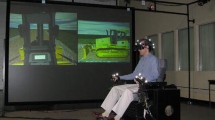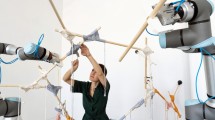Abstract
Fixtures play a significant role in ensuring the quality of products in manufacturing engineering. The paper considers fork-type parts that have a complex spatial configuration and needs to be machined by drilling-milling-boring equipment in one setup. In fixture design, it is necessary to provide wide tool accessibility, and therefore the choice of locating surfaces of the workpiece is an important step. The mathematical approach for determining the coordinates of contact points between the workpiece and the locating and clamping elements fixtures in the coordinate system is developed in this paper. The geometric parameters of the workpiece are taken into account in determining the coordinates. It allows to apply the proposed approach for parts of another standard size, but the same design and technological features. The technology of augmented reality is an effective tool at the design stage of fixtures and allows to visualize the developed fixture configurations. This approach has been successfully applied for such parts as levers, connecting rods, flat parts.




Similar content being viewed by others
References
Ivanov, V. (2019). Process-oriented approach to fixture design. In Ivanov V. et al. (Eds.), Advances in design, simulation and manufacturing (pp. 42–50). DSMIE 2018. Lecture Notes in Mechanical Engineering. Springer. https://doi.org/10.1007/978-3-319-93587-4_5.
Ivanov, V., Pavlenko, I., Liaposhchenko, O., Gusak, O., & Pavlenko, V. (2018). Computer-aided positioning of elements of the system “fixture - workpiece”. In 3rd EAI international conference on management of manufacturing systems (MMS-2018), 2279706. http://doi.org/10.4108/eai.6-11-2018.2279706.
Qin, G., Zhang, W., & Wan, M. (2005). Analysis and optimal design of fixture clamping sequence. Journal of Manufacturing Science and Engineering, 128(2), 482–493. https://doi.org/10.1115/1.2162908.
Liu, S.-G., Zheng, L., Zhang, Z.-H., Li, Z.-Z., & Liu, D.-C. (2006). Optimization of the number and positions of fixture locators in the peripheral milling of a low-rigidity workpiece. The International Journal of Advanced Manufacturing Technology, 33, 668. https://doi.org/10.1007/s00170-006-0507-5.
Krol, O., & Sokolov, V. (2018). Development of models and research into tooling for machining centers. Eastern-European Journal of Enterprise Technologies, 3(1–93), 12–22. https://doi.org/10.15587/1729-4061.2018.131778.
Xiong, C.-H., Wang, M. Y., & Xiong, Y.-L. (2008). On clamping planning in workpiece-fixture systems. IEEE Transactions on Automation Science and Engineering, 5(3), 407–419. https://doi.org/10.1109/TASE.2008.921483.
Qin, G., Ye, H., & Rong, Y. (2014). A unified point-by-point planning algorithm of machining fixture layout for complex workpiece. International Journal of Production Research, 52(5), 1351–1362. https://doi.org/10.1080/00207543.2013.842020.
Tarelnyk, V., Martsynkovskyy, V., & Dziuba, A. (2014). Applied Mechanics and Materials, 630, 388–396. https://doi.org/10.4028/www.scientific.net/AMM.630.388.
Cioata, V. G. (2008). Determining the machining error due to workpiece—Fixture system deformation using the finite element method. In Intelligent manufacturing and automation: Focus on next generation of intelligent systems and solutions (pp. 253–254).
Asante, J. N. (2008). A combined contact elasticity and finite element-based model for contact load and pressure distribution calculation in a frictional workpiece-fixture system. The International Journal of Advanced Manufacturing Technology, 39, 578. https://doi.org/10.1007/s00170-007-1187-5.
Zhou, X. H., Liu, W., Niu, Q., Wang, P., & Jiang, K. (2014). Locator layout optimization for checking fixture design of thin-walled parts. Key Engineering Materials, 572, 593–596. https://doi.org/10.4028/www.scientific.net/KEM.572.593.
Satyanarayana, S., & Melkote, S. N. (2004). Finite element modeling of fixture–workpiece contacts: Single contact modeling and experimental verification. International Journal of Machine Tools and Manufacture, 44(9), 903–913. https://doi.org/10.1016/j.ijmachtools.2004.02.010.
Rao, B. S., Malkapuram, D., & Ramjee, E. (2018). Force and deformation analysis for determination of optimum fixture configuration. International Journal of Applied Engineering Research, 13(7), 4675–4681.
Liao, X., & Wang, G. G. (2006). Simultaneous optimization of fixture and joint positions for non-rigid sheet metal assembly. The International Journal of Advanced Manufacturing Technology, 36(3–4), 386–394. https://doi.org/10.1007/s00170-006-0827-5.
Karpus, V. E., & Ivanov, V. A. (2012). Locating accuracy of shafts in V-blocks. Russian Engineering Research, 32(2), 144–150. https://doi.org/10.3103/S1068798X1202013X.
Mohring, H.-C., & Wiederkehr, P. (2016). Intelligent fixtures for high performance machining. In 7th HPC 2016—CIRP conference on high performance cutting, Procedia CIRP (Vol. 46, pp. 383–390). https://doi.org/10.1016/j.procir.2016.04.042.
Yang, B., Wang, Z., Yang, Y., Jing, Z., & Kang, Y. (2016). Determination of the number of fixture locating points for sheet metal by grey model. In MATEC Web of conferences (Vol. 95, p. 07018).
Chaari, R., Abennadher, M., Louati, J., & Haddar, M. (2014). Mathematical methodology for optimization of the clamping forces accounting for workpiece vibratory behaviour. International Journal for Simulation and Multidisciplinary Design Optimization, 5, A13. https://doi.org/10.1051/smdo/2013005.
Pavlenko, I., Trojanowska, J., Ivanov, V., & Liaposhchenko, O. (2019). Scientific and methodological approach for the identification of mathematical models of mechanical systems by using artificial neural networks. In 3rd Conference on innovation, engineering and entrepreneurship (Vol. 505, pp. 299–306). Regional HELIX 2018, Lecture Notes in Electrical Engineering. https://doi.org/10.1007/978-3-319-91334-6_41.
Kumar, E. R., & Annamalai, K. (2014). Investigation into optimal fixturing cost of an assembly using genetic algorithm. Engineering Review, 34(2), 85–91.
Vishnupriyan, S., Majumder, M. C., & Ramachandran, K. P. (2010). Optimization of machining fixture layout for tolerance requirements under the influence of locating errors. International Journal of Engineering, Science and Technology, 2(1), 152–162.
Hajimiri, H., Abedini, V., Shakeri, M., & Siahmargoei, M. H. (2018). Simultaneous fixturing layout and sequence optimization based on genetic algorithm and finite element method. The International Journal of Advanced Manufacturing Technology, 97(9–12), 3191–3204. https://doi.org/10.1007/s00170-018-1706-6.
Acknowledgements
The results of the paper were partially obtained within the National Scholarship Programme of the Slovak Republic (the research project “Identification of Parameters for Technological Equipment using Artificial Neural Networks”), as well as partially funded by the Ministry of Education and Science of Ukraine (The Project No. 0117U003931).
Author information
Authors and Affiliations
Corresponding author
Additional information
Publisher's Note
Springer Nature remains neutral with regard to jurisdictional claims in published maps and institutional affiliations.
Rights and permissions
About this article
Cite this article
Ivanov, V., Pavlenko, I., Liaposhchenko, O. et al. Determination of contact points between workpiece and fixture elements as a tool for augmented reality in fixture design. Wireless Netw 27, 1657–1664 (2021). https://doi.org/10.1007/s11276-019-02026-2
Published:
Issue Date:
DOI: https://doi.org/10.1007/s11276-019-02026-2




